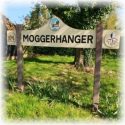MOGGERHANGER BEDFORDSHIRE
History and Present
Location
The rivers Great Ouse and Ivel join just north of Blunham. Close by to the South, partly on a low ridge, is the village of Moggerhanger. It was originally a hamlet of the parish of Blunham until becoming an ecclesiastical parish in its own right in 1860 and a civil parish in 1866. The present Moggerhanger parish is larger than the original by the addition of land from Northill parish in 1882.
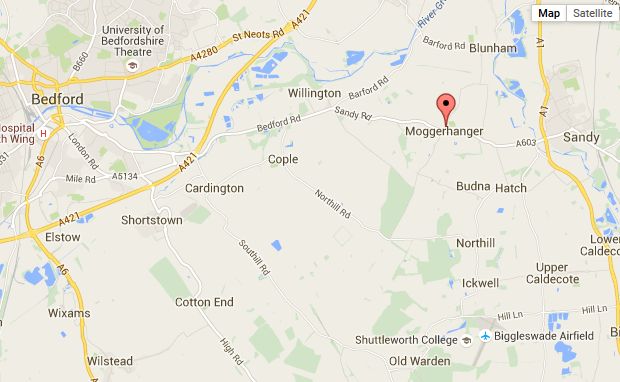
The parish of Moggerhanger comprises around 1815 acres, including the hamlets of Chalton and South Mills. Enclosure acts brought about a separation from Blunham in 1796.
Historical Names
Records can be traced back to 1216 mentioning the name of Moggerhanger in its various early forms. It has been known over the centuries by many different names including Mogahangr (1216), Mokerhanger (1276), Moukerhangre (1289), Morehanger, Muggerhanger and Mogerhanger.
Even now the parish tends to be spelled both with one ‘g’ (generally when referring to the civil parish) and two (generally in reference to the ecclesiastical parish); on the latest Ordnance Survey maps, the civil parish is spelt as Mogerhanger, with local pronunciation being ‘Morhanger’.
The meaning of its name – Mogerhanger or Morhanger – has been the subject of varying interpretations. The second part (hanger) comes from the Old English ‘hangra’, meaning ‘slope’; the first element is less certain.
One strong possibility is ‘bog or marsh on the hill’, because wherever one digs, one finds water!
“An underground stream is reputed to run from Brown’s field, under the A603 and eventually to Barford Bridge. This was apparently authenticated when a water diviner came to Moggerhanger and, tracing the route, lifted a large stone on Wilsher’s smallholding to find fast running water beneath it. The stone was replaced to prevent the possibility of accidents..!”
There is now a well in that position with the water level normally being only 1.5-2 metres below ground level!
Parish Church
The church of St John the Evangelist was built in 1860-1 to commemorate the Rev. Edward Henry Dawkins who died in 1859. Oak grown on the Moggerhanger estate was used for the roof of the church and its walls are local sandstone from Kempston and Silsoe. His widow, Mrs. Elizabeth Dawkins of Moggerhanger House, commissioned the church in his memory, and was a great benefactor of the village.
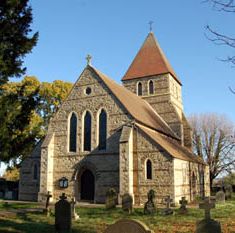
The church is very well maintained as is the churchyard. There has been great financial and practical support over the years from the village people, other organisations and from various grants. Apart from services, the church is also used for several community activities.
‘Friends of St John’s Church’ runs several fund raising activities annually. It is a registered charity for supporting the fabric and facilities of the church.
The Methodists and Baptists used to walk to Sandy or Blunham until 1928, when land for a chapel was provided by Mr Matthews of Village Farm. Sadly the chapel closed around 2012; a private house now stands on the site.
Chalton
Moggerhanger parish also includes the hamlet of Chalton to the north of the village. In the Domesday Survey (1086), Hugh de Grentmeisnil’s wife, Adeliza or ‘Adelaide’ possessed 10 hides in Chalton; the manor of Moggerhanger, not mentioned in the Survey, apparently was part of this larger property.
A hide is an Anglo-Saxon unit of land holding – usually sufficient land to sustain a family. This would vary in size depending on the quality of the soil, but was usually considered to be 15 to 30 acres (6 to 12 hectares).
Chalton Manor Farmhouse and dovecote were built in the Georgian style between 1735 and 1765. Pigeons from the dovecote provided the occupants with Squob Pie.
An 1822 police report states that “John Thomas and John Adams, fishmongers of Clerkenwell, were caught stealing pigeons from dovecotes in the area, found guilty and sentenced to seven years deportation”
Elizabeth Dawkins sold part of her land at Chalton Farm for a Railway Station at Blunham, a stop on the Bedford and Cambridge branch of the then London and North Western railway. This station and goods yard, no doubt greatly assisted the Victorian market gardening industry once prominent in that area. The station building still exists as a private house, and the goods yard has been used for modern housing.
Manor of Moggerhanger
One of the earliest owners of Moggerhanger manor is Roger de Trumpington, who held it at his death in 1289, and whose son, Giles, then inherited it. It stayed within the Trumpington family until 1457, when Sir Walter gave it to Maud Enderby in trust for her life, as her son, Richard, was pledged to marry his daughter, Eleanor. Richard Enderby held the manor from 1474 and, after he died only 13 years later, his son, John, transferred ownership to William Gascoigne. It passed then to the Aleyns, with John Aleyn possessing it by 1549. In the mid 1600s, the manor was alienated to Thomas Bromsall, and the next families to own it were the Astells, then the Thorntons, Robert Thornton succeeding his uncle Richard Astell in 1777. Moggerhanger passed to the Dawkins family of Over Norton, Oxfordshire, in the second half of the 19th century, then to Richard Mercer around 1888. Richard’s son, Colonel Algernon Mercer, sold it to the Fanes around 1909.
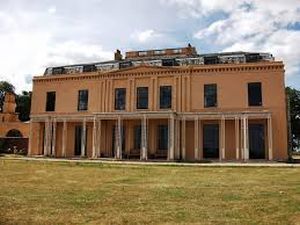
A manor house has been present in Moggerhanger Park since at least the 15th century, but the present Moggerhanger House is nearly entirely the work of Sir John Soane.
The Thornton family came to Bedfordshire in 1733. Godfrey Thornton was a director of the Bank of England He purchased the Moggerhanger Estate and employed Sir John Soane to redesign Moggerhanger House, which was completed in 1805. The estates of the Thorntons passed to the Rev. Henry Dawkins of Over Norton. He and his family took up residence in Morhanger House in the 1850s.
Godfrey Thornton, a cousin of William Wilberforce, was a Russia Merchant and a director of the Bank of England. It was he who around 1789 hired Sir John Soane, who had recently designed the Bank of England, to completely remodel Moggerhanger House (many of his plans and drawings for which are held in the archive of the Sir John Soane’s Museum at Lincoln’s Inn Fields in London). The gardens and grounds were designed by Humphrey Repton in the 1790s. The House was occupied as a family home until 1919, when it was purchased by the County Council for use first as a sanatorium and then as an orthopaedic hospital (ParkHospital) until its closure in 1987. After languishing unused for nearly a decade, it was purchased in 1995 by the Moggerhanger Preservation Trust. Both house and gardens have recently been restored thanks to English Heritage and enjoy Grade 1 listed status.
The extensive grounds include an ice house. The Woodland Restaurant and the conference centre welcomes visitors. Moggerhanger Park hosts weddings and other functions. In the spring there are magnificent snowdrop and bluebell walks.
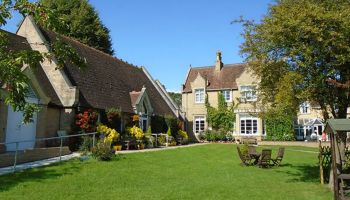
Sue Ryder Care
St Johns Palliative Care Home is on the east side of St Johns road. It was built in the 1850s by William Thornton as a shooting lodge. In 1977 Mrs Barbara Thornton sold it to the Sue Ryder Foundation and it is now a hospice serving a very large area. The organisation hold regular sales and large functions for fundraising.

Village School
Elizabeth Dawkins sold part of her land in 1861 for the village school on the site of the present village hall. In 1894 the school was enlarged by her son Edward Henry Frederick Dawkins to accommodate 60 pupils.
in 2011 the present village school celebrated its 100th anniversary, for Miss Cartwright and her pupils moved from the old school building in 1911.
The school has high values and standards which are reflected in the results of inspections and achievements. The school has its own website.
Village Hall
Vic Davison, the grandfather of Guy Davison later used the old school for storing potatoes and farm machinery. In 1937, the villagers got together and with the aid of some fund raising and an advantageous sale price, the building was acquired for use as a much needed Village Hall.
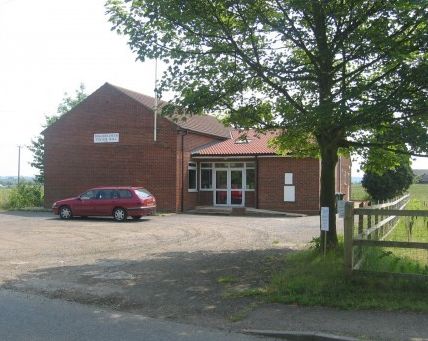
Once established, the venue was regularly used for dances, whist drives, dinners and a host of other social events. At that time the building was blessed with two open coke fires for heating and a bucket toilet!
At the outbreak of war and the hall had to be put to other uses. ARP wardens used the building and later, airmen from the nearby Tempsford Special Operations Executive were there. After the war, in 1946, the site was brought back into village use again. There was much work during the next few years, painting etc. but when doubts arose about the building’s structural integrity, it had to be demolished around 1976. Plans and fund raising followed eventually making way for a new replacement hall. This was completed in record time at a cost of £4500. The grand opening was by The Rev H Phoenix on April 2nd 1977.
In 2006 the hall was fortunate to get a Biffa grant to allow it to be upgraded with a disabled toilet. At the same time this enabled extensions to the lobby and the kitchen to be doubled in size.
Population
Though part of Blunham parish until the 1860s, separate population counts have been kept for Mogerhanger since 1801, and the figures show that it has never quite doubled in size in the intervening 200 years: 345 in 1801; 455 in 1851; 432 in 1901; 618 in 1951; and 638 in 2001.
Its highest population was recorded in 1991 (658), and its biggest jump was between 1921 and 1931, going from 398 to 575 in that decade.
Local Facilities
Being on a main road, the village enjoys a regular bus service to Bedford, Sandy and Biggleswade.
The church as well as being a place of worship, also acts as the local community meeting place.
There is a well recognised garage for servicing and repairs. The Guinea is an attractive public house and restaurant.
Moggerhanger Park has a business centre, which provides facilities for several Christian ministries. The main house provides full commercial conference facilities, special events and wedding venue facilities.
There is a good a number of small businesses and trades within the village.
Several agricultural and horticultural enterprises are within or near to the parish, as well as a transport company at Chalton and a manufacturer of corrugated paper, paperboard and containers at South Mills.
Text based on information from Central Bedfordshire Council and other local sources.
